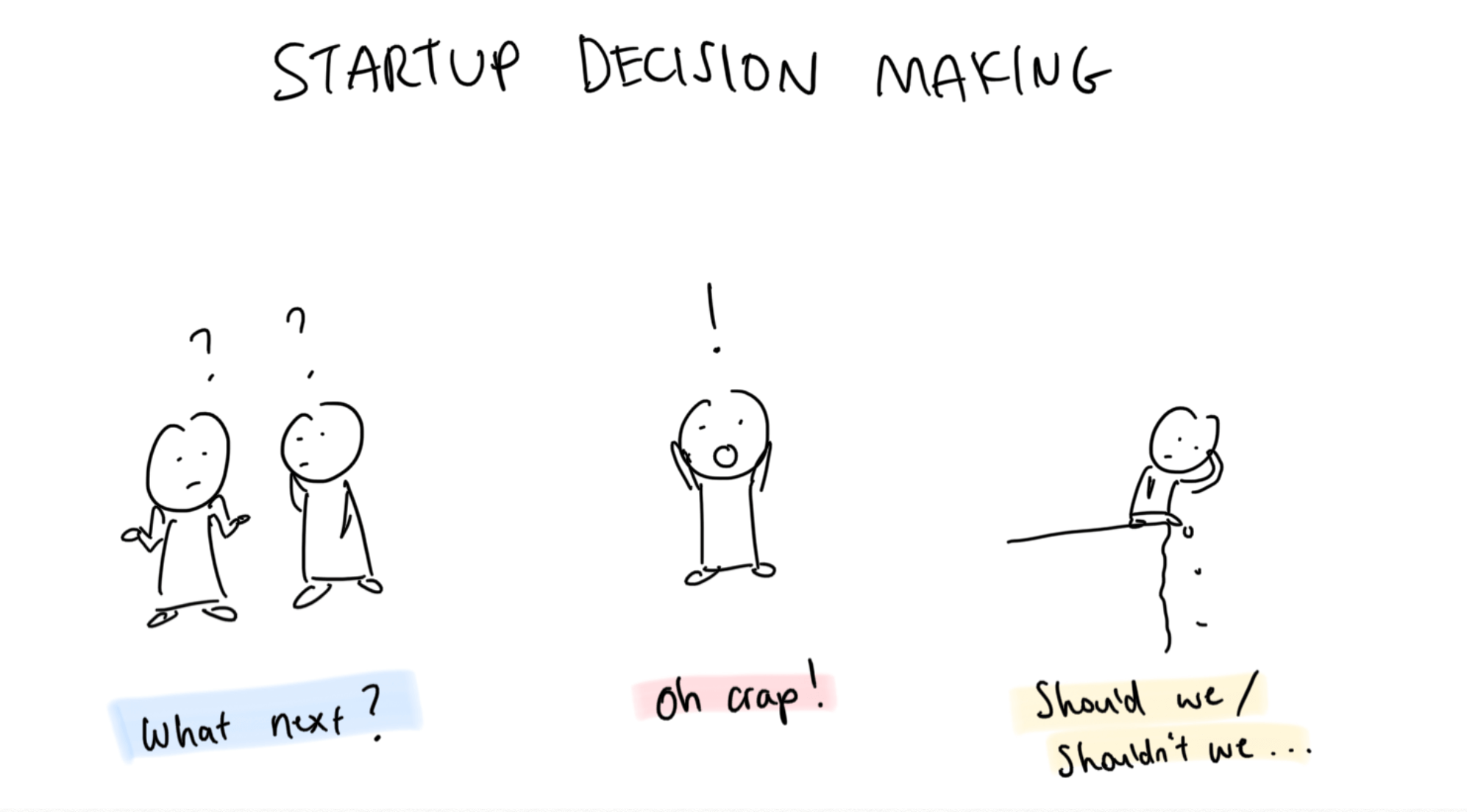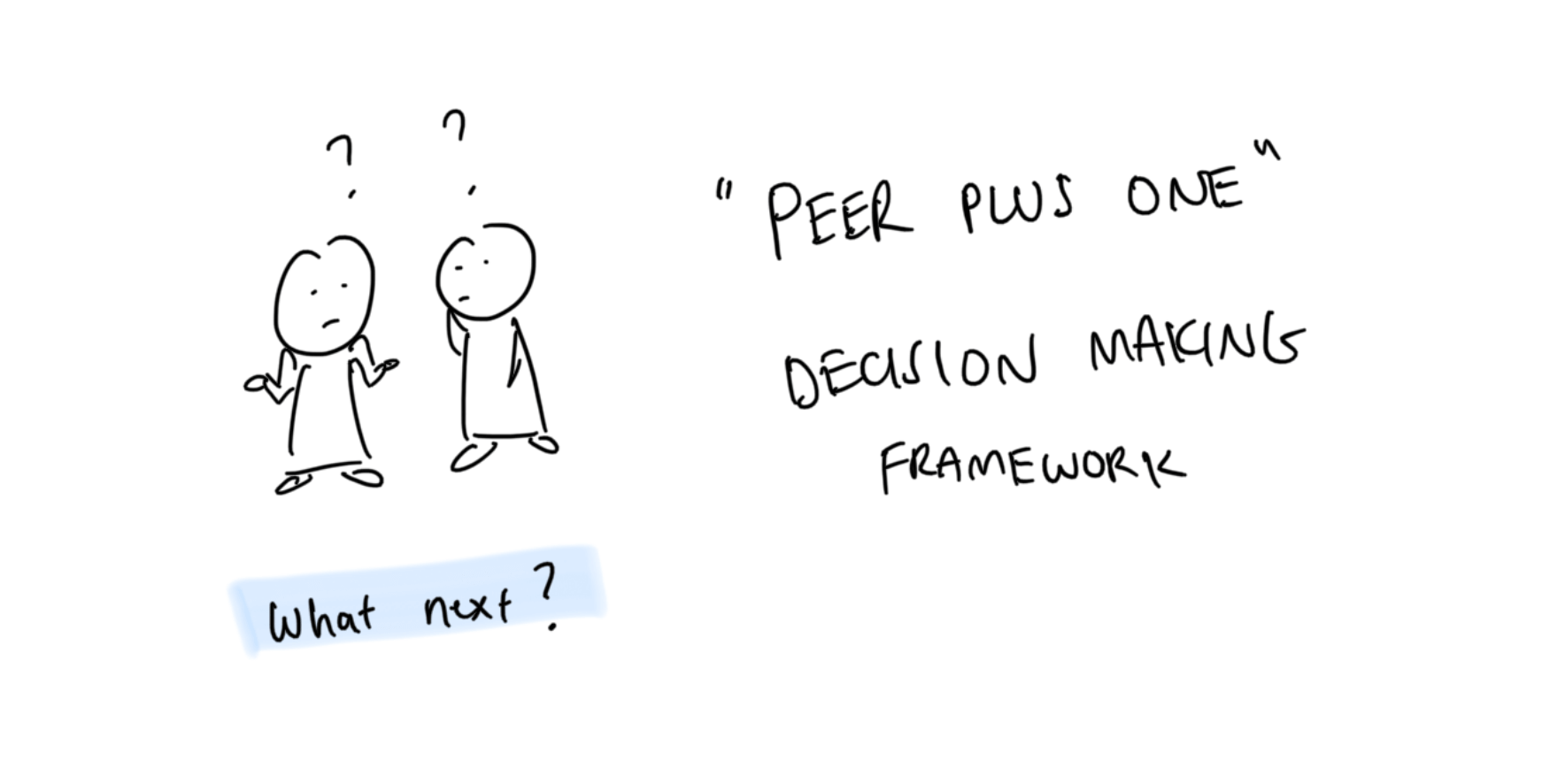3 Decision Making Frameworks Startups can use to Navigate Uncertainty
7 minute read | Apr 11, 2020
management, finance
People drawn to startups are often attracted to the rapid build and growth phase. But, the associated tax that comes with this is uncertainty, with common symptoms being decision making paralysis, poor incident response and unconsidered risk taking.

Here are 3 useful decision making frameworks startups can use to tackle each of these scenarios:
- 🤷♂️ What Next? -> Peer Plus One Framework
- 😱 Oh Crap! -> Incident Response Framework
- ⚠️ Should/ Shouldn't We? -> Risk Assessment Framework
1. What Next? -> Peer Plus One Framework
Decision making paralysis causes people to go back and forth on the same problem and can create anxiety, animosity and demotivate teams.

The late Andy Grove (Intel CEO) in his seminal 1983 book High Output Management laid out two decision making frameworks to help drive a decision and break paralysis under two scenarios: a. Technical/ Operational decisions b. Complicated/ Strategic decisions
A. Technical/ Operational decisions
Andy made the syllogism that:
- People are most technical when they start their careers and are on the frontline engaging with customers or problems daily;
- Managers who make decisions are further away from technical expertise and customers;
- Peer groups are bad at coming to consensus and paralysed by fear of accountability
Solution (Peer Plus One): To solve this, Andy supported having technical peer groups come up with solutions and options but someone one level senior to ratify or veto the decision. He coined this “Peer Plus One”.
B. Complicated/ Strategic decisions
For bigger, more complicated decisions (e.g. strategic or high risk), Andy proposed following a decision making framework all teams could use and answering 6 key questions in advance. It is summarised below with a problem scenario:
Problem: Intel decided to expand its Philippine manufacturing plant but did not know where. Options included a more expensive space next to the existing site to take advantage of existing infrastructure or purchasing a new cheaper plot of land nearby that would require more construction.
They were stuck in decision making paralysis. Let’s apply the framework below:
| Question | Example |
|---|---|
| 1. What decision needs to be made? | Build a site next to an existing plant or purchase and build a new building in a new location? |
| 2. When does it have to be made? | Plant needs to be operational in 2 years so construction must begin within a month |
| 3. Who will decide? | A team that comprised project managers of the construction and operations team. Decision heavily impacted both teams so getting key representatives to evaluate options was important. |
| 4. Who will need to be consulted prior to making the decision? | Key staff from both teams to be consulted on both options and implications |
| 5. Who will ratify or veto the decision? | Common report in this case being the CEO. Again this follows the “Peer Plus One” solution to drive the teams to come up with a solution |
| 6. Who will need to be informed of the decision? | Chairman |
In addition to expedited decision making, a consistent framework gives the teams that come up with the options comfort that their decisions are assessed based on merit with key people consulted.
2. Oh Crap! -> An Incident Response Framework
Incidents are inevitable. But, reactionary decisions can be ineffective, create further unintended negative consequences and demotivate people.

An effective incident response should seek to solve the real problem in a timely manner. Here is an framework applied to a scenario problem:
Problem: The Head of Marketing signed a multiyear $2m marketing software license without seeking CEO/ Board approval. The Head of Marketing is also a sibling of the CEO/ Founder. While within the marketing teams budget, the software was deemed to be non-critical and an unjustified business expense at this stage.
| Stage | Question | Example |
|---|---|---|
| 1. Define Problem | What incident needs to be resolved? | Significant unauthorised procurement by a member of the leadership team |
| 2. Investigate | What is the scope of the investigation required and who will lead? | Find out who authorised what and why. What frameworks were in place. Decide whether CEO should be removed from investigation due to conflict |
| 3. Freeze | What immediate action should be done to minimise the impact? | Curtail delegations in procurement across all teams? Not clear if this is one-off or systemic |
| 4. Remediate | How can we remediate/ resolve the incident? | Seek legal advice on validity of software license |
| 5. Action | What action should be taken following investigation findings? | What action should be taken on the Head of Marketing (formal notice/ termination)? Is an overhaul of the procurement procedure warranted? |
| 6. Message | What message should be communicated and to whom? | Does this warrant an all staff message on procurement policy and outcome of investigation or just to the marketing team? |
Following a consistent framework can help people remain calm and assess the underlying problem. Across all stages it is important to be clear on timeline and assign clear responsibilities and next steps.
3. Should We/ Shouldn’t We? -> Risk Assessment Framework
Poor risk taking can lead to negative consequences and similarly missed growth opportunities. Upside gains and downside risks from decisions are often shared disproportionately across teams. This can lead to poor communication and resentment.

Risk is often associated with danger and hazards. Risk management should not be confused with risk avoidance. The word “Risk” has its origins in the early Italian verb “riscare” meaning “to dare or to venture upon and take a chance”. A clear risk assessment framework can help teams make informed decisions in pursuit of growth.
Here is a simple risk assessment framework with an applied problem:
Problem: The sales team wants to offer a guarantee of software uptime delivery for an enterprise account and will promise a refund and added technical support if not achieved. The sales team believes this will help get the deal over the line. The delivery team is not confident of achieving the uptime and does not currently have resourcing for technical support. The teams are at an impasse.
| Stage | Question | Example |
|---|---|---|
| 1. Identify | What are the key risks? | Uptime is not achieved. |
| 2. Consequence | What is the consequence of the risk occurring? | 1) Customer requests refund. 2) Reputational damage from customer telling market about inability to deliver uptime |
| 3. Likelihood | Assuming the risk occurs what is the likelihood of the consequence? | 1) Medium: customer may ask for refund but unlikely to need technical support. 2) Low: unlikely customer would tell broader industry |
| 4. Controls | What controls can we put in place to limit the consequence? | Split the financial refund (if any) across the cost centres across the sales and delivery team. |
| 5. Assessment | Assess the residual risk with controls in place and determine if risk/ reward is acceptable. | Financial risk is lowered as sales team agrees to take less future commission if delivery team unable to achieve result. Reputational risk is low and customer deemed unlikely to tell broader industry. The gain of signing this enterprise account will have a greater upside on brand. |
Beyond minimising downside risk, an effective risk assessment framework can benefit startups with increased:
- Confidence: provides entire company with greater confidence towards strategic objectives while managing blind spots
- Communication: carefully considering and communicating risks/ reward helps improve team collaboration and drives faster decision making
- Compliance: being aware of and meeting legal and regulatory requirements of relevant decisions
Want more tips?
Get future posts with actionable tips in under 5 minutes and a bonus cheat sheet on '10 Biases Everyone Should Know'.
Your email stays private. No ads ever. Unsubscribe anytime.